25% of Americans Gay or Lesbian, Americans Think
A majority of Americans think homosexuals account for at least a fifth of the population.
A majority of Americans think homosexuals account for at least a fifth of the population.
Gallup (“U.S. Adults Estimate That 25% of Americans Are Gay or Lesbian“):
U.S. adults, on average, estimate that 25% of Americans are gay or lesbian. More specifically, over half of Americans (52%) estimate that at least one in five Americans are gay or lesbian, including 35% who estimate that more than one in four are. Thirty percent put the figure at less than 15%.
Gallup’s Lymari Morales:
There is little reliable evidence about what percentage of the U.S. population is in reality gay or lesbian, due to few representative surveys asking about sexual orientation, complexities surrounding the groups and definitions involved, and the probability that some gay and lesbian individuals may not choose to identify themselves as such. Demographer Gary Gates last month released a review of population-based surveys on the topic, estimating that 3.5% of adults in the United States identify as lesbian, gay, or bisexual, with bisexuals making up a slight majority of that figure. Gates also disputes the well-circulated statistic that “10% of the males are more or less exclusively homosexual.”
Americans’ current collective estimate — which is substantially higher than Gates suggests — is likely driven more by perceptions and exposure than by scientific measurement or reality. Gallup previously found that a majority of Americans personally know someone who is gay or lesbian, though Gallup did not ask Americans how many gay or lesbian individuals they know, or whether they know more individuals now than they did before. Additionally, Americans tend to have difficulty estimating percentages of population groups whose numbers are more widely known. Gallup a decade ago found Americans estimating much larger U.S. black and Hispanic populations than what the U.S. Census Bureau reported for those groups.
But the exposure explanation doesn’t make sense when you factor this in:
Americans with lower incomes and less education give the highest estimates, on average, of the U.S. gay and lesbian population, and far higher estimates than those with higher incomes and more education. Americans aged 18 to 29 give a higher average estimate than older Americans, and women give a far higher average estimate than men.
Certainly, I know a lot more open gays than I did when I was less affluent. Granted, public acceptance of homosexuality has happened in very short order. Still, it’s much more widespread in affluent, high education communities. This, on the other hand, makes perfect sense:
Democrats, liberals, and those who say they are socially liberal are also more likely to give higher estimates than those at the other end of the spectrum. However, the differences by political or ideological leanings are in most cases not as wide as those seen by demographic group.
Liberals have traditionally been more open to homosexuality, so it’s only natural that people in liberal communities would be more open about their homosexuality. Relatedly, those who wish to live openly as homosexuals and find partners are more apt to migrate to accepting communities. There are almost certainly more open homosexuals–if not more homosexuals, period–in New York and San Francisco than in Salt Lake City and Houston.
Americans perceive that there is a large U.S. gay population — one far larger than is likely reality. Perhaps more informative than the exact figure Americans give is the trend that more Americans now than in 2002 feel they have enough information to offer an estimate. This suggests Americans have had even more exposure to gays and lesbians, be it in their personal lives or through entertainment or other means.
It’s long been my thesis that exposure in the popular culture, mostly television, was the driving factor in changing public perception. Ironically, however, Americans’ knowledge of the numbers has gotten radically less accurate as their information–and confidence in their incorrect impressions–increased.
UNC economist Karl Smith takes a crack at explaining it.
About 3.5% of Americans identify as gay, lesbian, bisexual or transgendered. By contrast roughly 2.2% of Americans are ethnically or religiously Jewish and 4.8% of Americans are Asian. That is to say that LGBT folks are about 50% more common than Jews and 33% less common than Asians. Those give good anchors around what you would expect to see.
On the other hand, most Americans believe that there are significantly more gays and lesbians than blacks (12.6%) or Hispanics (16.3%) and 35% of Americans believe there are as many or more gays than Catholics (~25%)
What makes this interesting to me is not that people are bad at demographics. It’s that I would assume that people’s immediate experience is influencing their estimate of all of America. Yet, 52% of America can’t be experiencing anything like: 1 out of every 5 people I know is gay. So my guess is that most people don’t really get what these numbers mean in terms of their daily life. Of course, to some extent we already knew that but it always interesting to see it come out in actual data.
In other words, Americans–and, one imagines, people generally–are woefully innumerate. They simply don’t understand numbers, including even elementary percentages and other statistics. That’s why it’s impossible to have a rational public dialog about such things as federal spending, budget deficits, and the like. The numbers are too big and simply have no meaning to most people, for whom the difference between a million, a billion, and a trillion is simply theoretical.
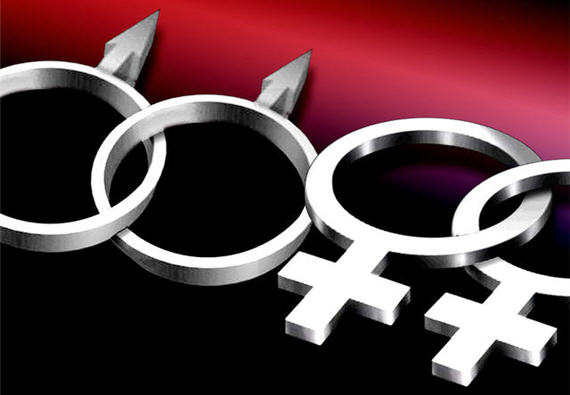
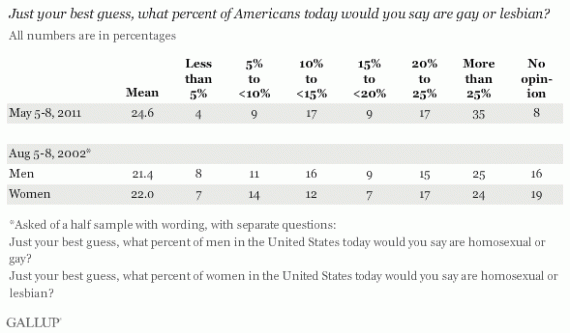
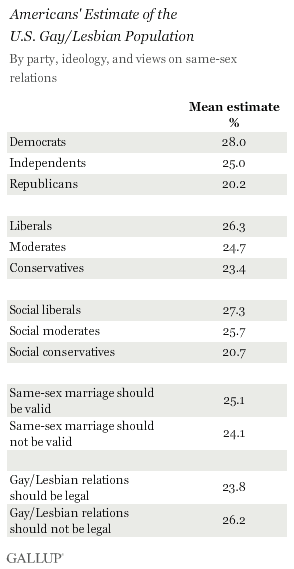

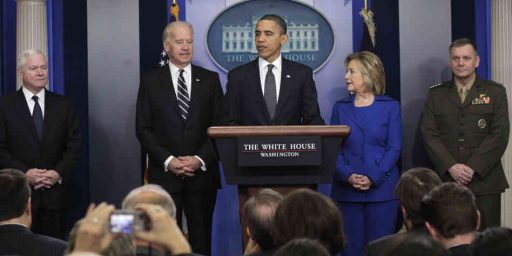
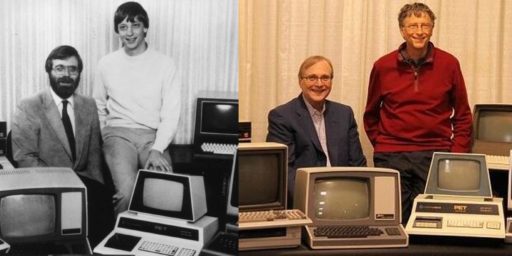

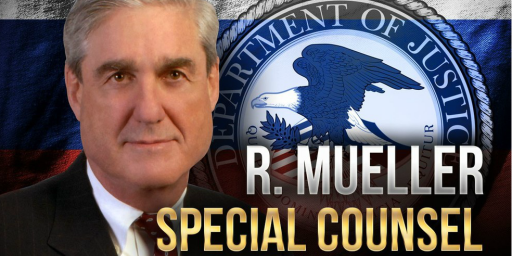
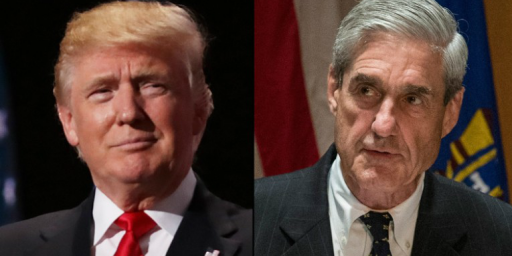
“Inummurancy” was the title of a book a few years back. In a conversation where grammar geeks jump on people for mis-using ‘lay’ and ‘lie’, no one will bat an eye if someone says “since there is a 50% chance of rain Saturday, and 50% on Sunday, that proves there will be a 100% chance of rain this weekend”. People are proud to say, “Oh, I’m not a math person”. Yet these people will extrapolate the weirdest ‘facts’ from limited data. Too bad.
John,
Yes, I read John Allen Paulos’ 1990 masterwork “Innumeracy: Mathematical Illiteracy and Its Consequences” and his 1997 follow-on “A Mathematician Reads the Newspaper” years ago. They’re great–and completely accessible for those of us whose math skills top out at algebra and basic statistics.
“The survey, conducted by the WorldPublicOpinion.org project at the University of Maryland’s Program on International Policy Attitudes, asked the question: “What percentage of the federal budget goes to foreign aid?”
The median answer was roughly 25 percent, according to the poll of 848 Americans. In reality, about 1 percent of the budget is allotted to foreign aid.”
http://www.pbs.org/newshour/rundown/2010/12/foreign-aid.html
Making percentages add up to 100 is so…limiting.
Headline as it shows here:
25% of Americans Gay or Lesbian, Americans Think
Doctor Freud, call your office.
Oh, dropped the comma. Never mind.
Innumeracy isn’t restricted to average Americans.
When I was in grad school one of the things I did to keep body and soul together was tutor social sciences grad students in statistics. I find it distressing that some of these guys are probably heads of departments today.
Translation: One fifth of characters portrayed on TV, in movies, and music are homosexual.
Perception is reality – and the goal of propaganda.
Yes, a lot of people are innumerate (that goes without saying), but poll respondents were much worse at estimating the percent of gay persons than percents of African Americans, Asians, etc. Can we explain why they worse at that particular estimate and/or are such patterns significant/interesting?
I don’t know, but explaining the magnitude of error in that particular measure as a result of general innumeracy is like explaing the very high popularity of Fried Green Tomatoes on human sentimentality.
If the magnitude of error in this case is significant, perhaps one factor is that people make guesses concerning whether people they know/encounter are gay, whereas they are not usually making guesses about race.
It’s not remotely fair to accuse Americans of innumeracy based on a poll like this. How are people supposed to know the precise percentage of some demographic subgroup, unless they read the number somewhere? The poll asks them to make a wild-ass guess, which they dutifully did, and now we make fun of them because their guess wasn’t perfectly accurate? For those of you convinced that you yourself are not innumerate, try guessing (without Googling) the answer to a question like “How many people in America have cancer?” and see if your answer is correct to even one significant figure.
There’s plenty of evidence that Americans are innumerate, but this isn’t it.
c says: that’s a fair point, too, but it still leaves the question of why the respondents’ guesses would be so far off on that particular demographic subgroup.
I do think that innumeracy is at the heart of this (like the poll that showed people thought 10% of the budget went to NPR).
And while one suspects that pop culture does have a hand in perceptions about homosexuality (for good or ill), before we get all monocausal on the issue let’s not forget that social conservatives, Evanglicals in particular, have been warning us all of the “homosexual agenda” for years, including the implicit (and sometimes explicit) suggestion that they are actively campaigning to recruit the youth. If there really is a massive homosexual conspiracy out there, one could imagine a lot of people thinking, there must be a substantial number of Them out there, yes?
I agree with PGlenn’s point, this isn’t a result of innumeracy, just because it’s an error involving a number. Innumeracy is errors that result from lack of mathematical skill, which doesn’t seem to be the case here. This is just simple ignorance.
I doubt if it is even 1% homosexual. That is unless you live in San Francisco. Probably 25% there. If it is 25% and there are 4 bloggers at OTB, which one is gay?
Duh! The one using italics.
Uh, oh…
For those of you convinced that you yourself are not innumerate, try guessing (without Googling) the answer to a question like “How many people in America have cancer?” and see if your answer is correct to even one significant figure.
Point taken. I guessed about 10%, in fact it’s about 4%.
Mr. Taylor, we’d expect a respondent’s innumeracy to remain constant as he/she went from one guess to the next, yet the magnitude of error is much greater on the guesses pertaining to percent of population that is gay versus percent that is African American, Asian, Latino.
Now, it’s possible that respondents were more likely to know the “right” answers to the other questions ahead of time (which was my point above) and thus more of them had to make guesses on the percent of gays. Innumeracy would likely be a factor contributing to “bad” guesses, but we cannot say that it would be the most important factor (“at the heart of this”).
As you suggest above, social perceptions would likely play a role. At essence, innumeracy simply means being bad at math (due to unfamiliarity with its methods), but estimating the percent of gay persons would be filtered through one’s perceptions, based on media, social interactions, anecdotes, etc. In other words, there’s plenty of room for error before the math even gets started.
On that note, who were you even responding to above? locomotivebreath blamed media “propaganda” for popularizing the notion that homosexuality is common (yes, he/she did kinda go “monocausal”); he/she did NOT say anything about a “conspiracy.” As a rule, a conspiracy that relies on heavy saturation of the public airwaves with “proganda” would not be able to keep its mission secret for very long. Btw, locomotivebreath has a point, if we determine that it’s worthwhile to consider the possible MULTIPLE causes of why people are such bad guessers when it comes to percent of population that is gay.
i live in a small apt. complex with 7 apts…. 10 people live in the complex… 2 people living together are gay, so if everyone has an automobile and 14 % of the apts are gay occupied by 20 % of the people…. if one resident leaves the apts and walks west towards the carport and meets another resident 5 minutes later walking east toward the apts., what are the odds that either person is gay and has only one arm???
I love the way this guy comes along and demonstrates a whole new level of ignorance.
The gayest show on TV is GLEE, hands down. IIRC there are four named characters who are gay — one major, three supporting. Out of a cast of 10 major and at least a dozen supporting characters. There is room for dispute on who is major or supporting as it shifts a bit, but basically I’d say this incredibly gay show has about 10-15% gay characters overall.
As for TV broadly? The number is probably right about where it is in the available demographics: about 5%. Preceded of course by decades where zero characters were gay.
The fact that you believe this to be true proves the point that people are terrible at estimating things.
michael reynolds wrote, “. . . this guy comes along and demonstrates a whole new level of ignorance.” Are you implying that previous level(s) of ignorance had been part of this story before locomotivebreath came along? If so, what were those levels, specifically?
PGlenn:
I estimate the ignorance levels at 42%.
MM and michael reynolds: technically, locomotivebreath made a bad guess on the percent of t.v./movie/media characters/personalities who are gay (I suspect he was being at least a little bit facetious). Aside from implying he is homophibic, though, neither of you really refuted his point, which is that the possible public misperceptions in this case might be (partly) driven by pop culture.
Also, keep in mind that the actual number in the general population (not the media) is reported to be, what, around 3 percent? Thus, there’s no “room” on the “low side” in which to make a bad guess. Guessing 1 percent is close to the target. That, by itself, would skew the numbers upward. On top of that, is there any chance that pop culture helped nudge it some more?
michael reynolds: sorry, I wasn’t very clear at all. I was wondering if you had in mind other SOURCES of ignorance that would have contributed to previous LEVELS of ignorance pertaining to this story. Bad wording on my part.
You wrote that locomotivebreath came along and demonstrated a whole new level of ignorance. I was wondering what factors you perceived to have contributed to levels of ignorance before locomotivebreath showed up?
@C: This is innumeracy for the reasons Karl Smith suggests. Using simple logic and extrapolating from personal experience, one ought to come up with a much, much smaller number. Unless you’re living in San Francisco and all your acquaintances are hairdressers and interior designers, it’s highly unlikely that one in five people that you know is gay. But a lot of people don’t really understand what “20 percent” means.
it is driven by the MSM and Hollywood. Outside their small social area, people learn of the world via the news and entertainment. Mostly because people don’t sit around worry about how many homosexuals there are so when asked they use the media perception. Ask people about how many people get lung cancer. Due to the misleading propaganda, they’d probably say millions. But in 2007 the incidence was just 65.6 per 100,000 0r 203,536 people diagnosed. Prostate cancer has the highest incidence in the US but we hear almost nothing about that so people would underestimate if asked to estimate.
The real question is, if the percentage of gay or lesbians is so low, why are they or gay culture so much a part of the liberal entertainment presented?
@JKB:
I used to think that as well, but, I have found that actually, some people do–although I wouldn’t hazard a guess as to how many…
Still, if you don’t think that there aren’t people who sit around and worry about these things, you haven’t been to a small southern town or a conservative evangelical church.
While it is no doubt the case that media influences perceptions, as has already been noted, even if one wants to blame the misinterpretation on the media, the number is still problematic, because 25% of characters on TV shows and movies are not portrayed as homosexuals.
Mr, Joyner, you’re contradicting yourself: This is innumeracy [bad math] . . . using simple logic [which is not necessarily mathematical] and extrapolating from personal experience [filtered through perceptions, most definitely not a pure matter of mathematics], one ought to come up with [better math] . . .” It’s far more likely that the average person knows what 20 percent means than he/she has the vaguest clue how many gay persons they know/encounter (he/she is guessing).
Well, the only thing keeping us from already having become a banana republic is that around 25% of the zombified masses literally are too stupid to vote. Thank goodness.
Along those lines, the main thesis here absolutely is correct. The American public is shockingly innumerate. You’d have a better chance teaching a dog to break dance than to convince Joe and Jane Zombie Robot that a trillion dollar budget deficit is a bad thing. Thanks in no small part, of course, to the disintegration of the K-12 public money school systems as a result of leftism.
@PGlenn: Innumeracy isn’t the inability of average people to do complex mathematical calculations, much less having memorized numerical data accurately. Rather, it’s about the inability to make reasonable guesses about the world around them using mathematical reasoning.
Extrapolating from personal experience is, of course, dangerous, in that we see only a part of the world. But it’s simply unreasonable for most people to guess that more than a quarter of their fellow citizens are gay–and yet the plurality do just that.
Oh, why don’t you take a shot at answering that question…
Is there anything wrong with this country that isn’t the fault of the left? By the way, if we want to talk about how foolish people are, we can talk about how foolish it is to tackle that trillion dollar budget deficit simply by cutting foreign aid, the Department of Education, and domestic social programs without any tax increases or cuts in defense spending…
PGlenn:
I was referring to the ignorance demonstrated in the original poll.
@James Joyner: Your excerpt from Smith says
The evidence (people’s estimates of the gay population) is inconsistent with that assumption. Rather than reconsidering whether the assumption is correct, Smith (and you) infer that there must be some other explanation for the discrepancy – namely, that people don’t know what percentages mean. Maybe they do and maybe they don’t, but I’d think we ought to establish the correctness of that initial assumption first.
Personally I doubt that people are basing their estimate on their own experience. Rather, since gay rights are a major issue in American politics and culture these days, they may be assuming that the size of the population affected by that issue must be large. That’s a reasoning error of some type, but it doesn’t mean everyone who makes it would fail at math.
James Joyner wrote, “Innumeracy isn’t the inability of average people to do complex mathematical calculations, much less having memorized numerical data accurately.” Actually, that would be an example of innumeracy, but then I never referred to the inability of people to do complex mathematical calculations, and I went out of my way to point out that, if people knew the answers ahead of time (memorization), that would be an example of when math wouldn’t come into play.
I’m guessing that you’re basing your definition of innumeracy on the theme of a book (with which I am unfamiliar) rather than the accepted “dictionary” defintion of the word.
“Rather, it’s about the inability to make reasonable guesses about the world around them using mathematical reasoning.” Wrong, that’s one example of when innumeracy would hinder people. But innumeracy includes ANY unfamiliarity with mathematical concepts, not just quantitative reasoning pertaining to observed social phenomena.
This was not a case when we can simply say generic, universal “innumeracy” or generic, universal “ignorance” and then glide on by, at least not if we’re traying to explain the magnitude of error among the different groups responding to the poll. But then I can see why y’all would want to glide over the other explanatory factors. I’ll give you credit, though, for knowing when the play things nice & simple . . .
I think an accurate estimate of the LGBT population will be impossible until they’re no longer afraid to come out of the closet.
43% of all statistics are worthless.
It’s clear what’s going on here. The number of gay people is increasing at a huge rate, and only certain demographics can see the truth.
They must be recruiting!
http://www.queerty.com/mt-state-rep-ken-peterson-wants-any-gays-caught-recruiting-straights-to-be-jailed-for-10-years-20110407/
Here, young Mr. Joyner, your hormones are raging. Let’s go in this bedroom, and we’ll engage in some homosexual acts. You’ll find you like it.
Are you sure it wasn’t that 1/5th of Americans are gay or that Americans are 1/5th gay? In all seriousness Australia has it in there census and tracks it at 12 – 17% of their population.